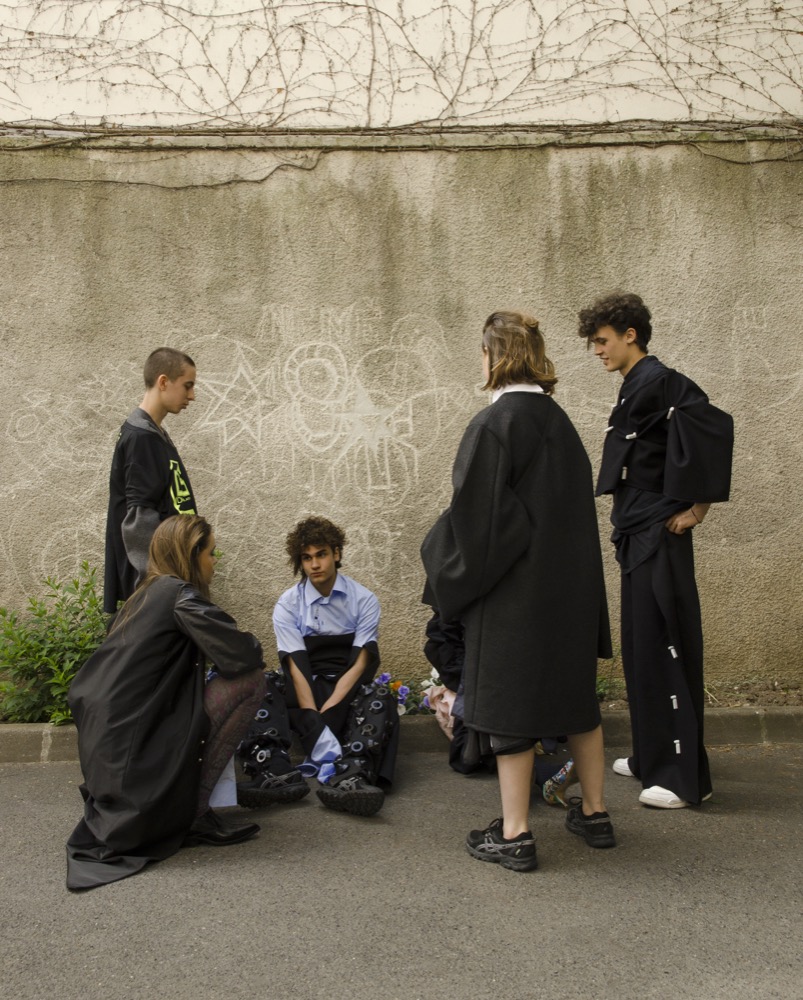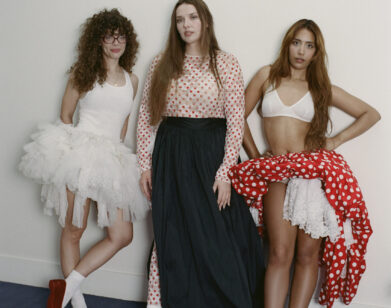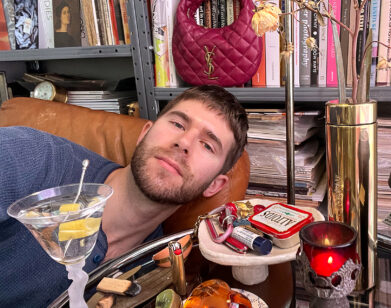How Afterhomework took over Paris fashion week
Pierre Kaczmarek, 18, and Elena Mottola, 20, are the young couple behind Paris-based fashion brand Afterhomework. Starting out in 2014 as a line of t-shirts, Afterhomework soon debuted a full collection and today showed its third collection at Paris fashion week. The name came easily—working on the brand was sandwiched between philosophy and geography homework for a then 15-year-old Kaczmarek.
By playing with outré shapes—a dress made out of dad’s ties, crewneck tees sewn into one bulky shirt—the Parisian brand is pushing past convention, refusing to position itself within a mile radius of anything overtly commercial. And fashion’s biggest players are taking notice. Everything Kaczmarek has learned in his nascent design career came from the internet or older, more experienced friends. He plans on keeping it D.I.Y., having expressed no interest in attending fashion school once he graduates.
Despite racking up headlines and fielding calls from the French Fashion Federation, Kaczmarek and Mottola are still barely breaking even. It’s a struggle, they say, to be working at fashion’s highest level with the budget of a sophomore. To be taken seriously, they are doubling down on their work ethic, and letting someone else take care of the business side.
Recens Paper’s editor-in-chief Elise By Olsen, 17, faces a similar uphill battle to be taken seriously with her publishing ventures. Yet both are giving the status quo a healthy shake. They know all too well that after homework is done, the real fun begins.
ELISE BY OLSEN: What are you working on right now?
PIERRE KACZMAREK: We’re finishing the last pieces of our next collection and organizing a show for it during Paris Fashion Week.
OLSEN: I admire that you’re actually able to work with a whole machinery around your brand—you have an agency and a commercial agent. It’s unusual for an emerging brand. I find it very scary to leave my work in the hands of others. When working so hard over a long period of time on something—whether it’s a collection of clothes or magazine content-you have to trust that the eventual apparatus is fully backing you and seeing your vision clearly.
ELENA MOTTOLA: We get more time to work on what we’re best at. It helps us to be completely focused on the clothes and the creative part of the brand, although most of our recent press has come from ourselves.
OLSEN: I wanted to quote an interview with [the late Maison Martin Margiela co-founder] Jenny Meirens conducted by Jeppe Uglevig for 1Granary published earlier this year: “Fashion business doesn’t have to be a compromise on creativity. I think it’s really a total misunderstanding with young people today, who think that being more commercial means being less creative.” I think that’s well put.
KACZMAREK: Yes, but we find it hard to combine the creative part and the business part, and so we have to have someone taking care of it. Also because people are scared of our age, that it’s somehow equivalent of ignorance and amateurishness. That whole age narrative is a good story for the press, but not necessarily for the sales. We have experienced it as a real struggle.
OLSEN: I can relate, but I do find the synthesis of creativity and commerce highly interesting. And if one does want to manage oneself, there are options … I’ve heard stories about people pretending to have a whole team, managing several email accounts, one for the financial department and one for the press department—or even shifting their voices on phone calls. “Let me just transfer you to my assistant.” [clears throat] “Hello?”
KACZMAREK: Who are these people? Do you do this, Elise?
OLSEN: No, but I have certainly been working on my email etiquette…
KACZMAREK: Back to the subject again, I don’t even think it’s our job as designers to price the clothes or sign retail deals. I might want to learn it sometime, but it’s currently impossible to handle while studying philosophy and history at school.
OLSEN: How do you make it work financially for Afterhomework?
KACZMAREK: We don’t … We don’t earn money yet, but we’re left with zero. There are some brands that have given us some project funding. We have done some paid talks in fashion schools and my grandmother got us some boost money in the very start.
OLSEN: Now that your fashion show is coming up, do you feel that people have expectations for what you will do next?
KACZMAREK: Yes. I think people are curious about what the show will be. At our last show we had great attendance; it was covered by French television, press and buyers. Also, a representative from the French Fashion Federation called us last week. Even though we’re not on the official fashion week calendar, he asked us to move our show up a half an hour as the show would clash with Pascal Millet’s show—and so they were worried no one would go to his.
OLSEN: How do you feel about the dynamics of being a couple and also running a brand together?
MOTTOLA: If we were older, it’s unlikely people would care about the dynamics of the brand. People tell us that, in the case of us splitting up, it’s dangerous for the company that we’re a couple. But we think it’s a strength for the brand. We’re always together and can therefore work on it whenever we want. We bounce ideas back and forth, merge each other’s skills—collaboration is key. People will get it in awhile, we just have to be patient.
OLSEN: And you can be patient also.
KACZMAREK: But we aren’t. Maybe I’m done with fashion in a few years, I don’t want to only do one thing in my life.
OLSEN: What would you do if not fashion?
KACZMAREK: I don’t know. For the moment I really like being in fashion.
OLSEN: I’d be a surgeon.
KACZMAREK: Exactly! To be open to make career changes is a benefit. It’s also something about ending a project at its peak. When the day comes where we feel Afterhomework is complete, we’ll quit immediately.
OLSEN: To be satisfied isn’t good, one always has to strive for progress. Do you though think that you’ll ever hit a point where there’s nothing left to be done, where Afterhomework is the best that it can be?
MOTTOLA: We don’t know the feeling of satisfaction. It’s never as good as we want. But it’s something about still putting stuff out there, even though it could be worked on for ages and ages, and practice on the way. Between each collection there’s a learning curve.
OLSEN: What advice would you give to other young, aspiring designers?
MOTTOLA: We can only teach by example.
OLSEN: You’re both in school. What do you feel about education in creative industries?
MOTTOLA: We believe in technical education. Creativity can’t really be taught, but learnt by doing.
OLSEN: What do you do after homework?
KACZMAREK: First homework, then Afterhomework and after we hang out with friends or watch sports.
OLSEN: Pierre, lastly, I know you have a passion for football.
KACZMAREK: Yes. I like to draw a comparison between fashion and football. It’s connected. Not only aesthetically, but also in terms of the mentality. Both fashion and football is a game.







